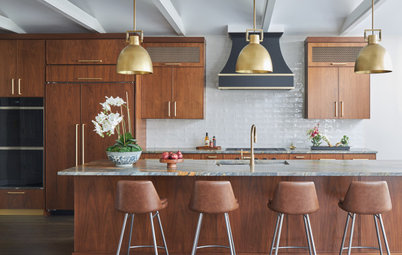Industry Research
Pros Are Mildly Optimistic Despite Slowed Activity in Q2 2023
Expectations are restrained and construction pros report record-high backlogs in the Q3 2023 Houzz Renovation Barometer
More professionals across the construction and design sectors anticipate business growth than expect declines in the third quarter of 2023 — a moderate outlook despite slowed business activity and other headwinds. And backlogs have lengthened in the construction sector to a record-high 13 weeks. Those are key takeaways from the just-released Q3 2023 Houzz Renovation Barometer, which provides timely insights into the impact of recent economic volatility on the home improvement market.
“Pent-up demand and macroeconomic conditions, such as aging housing stock and high mortgage rates, which continue to drive home improvement activity, are instilling a sense of optimism among builders, remodelers, architects and interior designers as they look ahead to the second half of the year,” said Marine Sargsyan, Houzz staff economist. “We continue to monitor the industry to identify whether improvements to inflation and other economic indicators create more stable pricing for businesses and an environment in which homeowners proceed with their full project scope. That said, ongoing labor shortages and product and material delays will continue.”
“Pent-up demand and macroeconomic conditions, such as aging housing stock and high mortgage rates, which continue to drive home improvement activity, are instilling a sense of optimism among builders, remodelers, architects and interior designers as they look ahead to the second half of the year,” said Marine Sargsyan, Houzz staff economist. “We continue to monitor the industry to identify whether improvements to inflation and other economic indicators create more stable pricing for businesses and an environment in which homeowners proceed with their full project scope. That said, ongoing labor shortages and product and material delays will continue.”
A score higher than 50 indicates that more firms reported increases in their business expectations than reported decreases.
Construction Firms
1. Business activity expectations increased. Construction professionals are optimistic about business in the third quarter of 2023. The Expected Business Activity Indicator increased from 51 in Q2 2023 to 54 in Q3, with expectations for both project inquiries and new committed projects increasing quarter over quarter (from 51 to 54 and from 52 to 53, respectively).
Looking by business type, build-only remodelers anticipate an increase in business activity in Q3 (54 compared with 50 in Q2), while expectations among design-build firms remain the same for Q3 at 53.
The indicator is based on survey questions about whether businesses expect the number of project inquiries and new projects to increase, decrease or remain unchanged in the coming three months compared with the previous three months.
Construction Firms
1. Business activity expectations increased. Construction professionals are optimistic about business in the third quarter of 2023. The Expected Business Activity Indicator increased from 51 in Q2 2023 to 54 in Q3, with expectations for both project inquiries and new committed projects increasing quarter over quarter (from 51 to 54 and from 52 to 53, respectively).
Looking by business type, build-only remodelers anticipate an increase in business activity in Q3 (54 compared with 50 in Q2), while expectations among design-build firms remain the same for Q3 at 53.
The indicator is based on survey questions about whether businesses expect the number of project inquiries and new projects to increase, decrease or remain unchanged in the coming three months compared with the previous three months.
2. Project backlogs are longer than they were a year ago. The average wait time before a company can start work on a new midsize project reached a record-high 13 weeks nationally at the start of Q3 2023 across the construction sector. That’s up 2.5 weeks compared with the same period last year — and more than double pre-pandemic levels in Q3 2019.
Breaking it down by subsector, the wait times are 14.5 weeks for build-only firms (5.7 weeks longer than a year ago) and 11.5 weeks among design-build firms (nearly a week shorter than a year ago).
Breaking it down by subsector, the wait times are 14.5 weeks for build-only firms (5.7 weeks longer than a year ago) and 11.5 weeks among design-build firms (nearly a week shorter than a year ago).
The increase in average wait time in the construction sector overall is primarily driven by the New England region (Connecticut, Maine, Massachusetts, New Hampshire, Rhode Island and Vermont), which has an average reported wait time of 21.8 weeks.
Year over year, backlogs for the construction sector are longer across eight of nine Census divisions — in all but the West South Central division (Arkansas, Louisiana, Oklahoma and Texas), which, at 7.9 weeks, has the shortest reported wait time for starting work on a new midsize project.
Professionals reported continued delays in shipments of products, as well as homeowner requests to postpone or reduce the scope of their projects in the first half of the year.
Year over year, backlogs for the construction sector are longer across eight of nine Census divisions — in all but the West South Central division (Arkansas, Louisiana, Oklahoma and Texas), which, at 7.9 weeks, has the shortest reported wait time for starting work on a new midsize project.
Professionals reported continued delays in shipments of products, as well as homeowner requests to postpone or reduce the scope of their projects in the first half of the year.
A score lower than 50 indicates that more firms reported decreases in their recent business activity than reported increases.
3. Recent business activity decreased. For Q2 ’23, the construction sector’s Recent Business Activity Indicator score was 43, down 2 points from Q1. The lower score was driven by a 4-point decline in project inquiries in Q2 relative to the previous quarter. New committed projects remained steady at 47 in Q2.
Looking at the data by business group tells a more nuanced story. Among build-only remodelers in Q2, recent business activity increased (44 in Q2 compared with 42 in Q1). Design-build remodelers reported a decrease in recent business activity (42 in Q2 compared with 48 in Q1).
The Recent Business Activity Indicator looks at actual activity over the previous three months. In contrast with the Expected Business Activity and Project Backlog indicators, which look forward in time, the Recent Business Activity Indicator looks back. It’s based on survey questions about whether businesses observed an increase, decrease or no change in the actual number of project inquiries and new committed projects over the previous three months relative to the three months before that.
3. Recent business activity decreased. For Q2 ’23, the construction sector’s Recent Business Activity Indicator score was 43, down 2 points from Q1. The lower score was driven by a 4-point decline in project inquiries in Q2 relative to the previous quarter. New committed projects remained steady at 47 in Q2.
Looking at the data by business group tells a more nuanced story. Among build-only remodelers in Q2, recent business activity increased (44 in Q2 compared with 42 in Q1). Design-build remodelers reported a decrease in recent business activity (42 in Q2 compared with 48 in Q1).
The Recent Business Activity Indicator looks at actual activity over the previous three months. In contrast with the Expected Business Activity and Project Backlog indicators, which look forward in time, the Recent Business Activity Indicator looks back. It’s based on survey questions about whether businesses observed an increase, decrease or no change in the actual number of project inquiries and new committed projects over the previous three months relative to the three months before that.
A score higher than 50 indicates that more firms reported increases in their business expectations than reported decreases.
Architectural and Design Firms
1. Business activity expectations decreased (but remained positive).
Architecture and design firms are also modestly optimistic about project inquiries and new committed projects, with an Expected Business Activity Indicator score of 52 for the third quarter of 2023. The score is 4 points lower than business performance expectations in Q2 2023, indicating that a slightly lower number of firms expect their business activity to improve in Q3 rather than decline compared with the previous quarter.
The decline in the overall indicator was primarily driven by a 6-point drop in expectations for new committed projects. Expectations for project inquiries are down by 3 points in Q3.
Looking at the business groups individually, expectations decreased among architects by 3 points (52 in Q3 compared with 55 in Q2) and by 5 points among interior designers (52 in Q3 compared with 57 in Q2).
Architectural and Design Firms
1. Business activity expectations decreased (but remained positive).
Architecture and design firms are also modestly optimistic about project inquiries and new committed projects, with an Expected Business Activity Indicator score of 52 for the third quarter of 2023. The score is 4 points lower than business performance expectations in Q2 2023, indicating that a slightly lower number of firms expect their business activity to improve in Q3 rather than decline compared with the previous quarter.
The decline in the overall indicator was primarily driven by a 6-point drop in expectations for new committed projects. Expectations for project inquiries are down by 3 points in Q3.
Looking at the business groups individually, expectations decreased among architects by 3 points (52 in Q3 compared with 55 in Q2) and by 5 points among interior designers (52 in Q3 compared with 57 in Q2).
2. Wait times are shorter than they were a year ago. At the start of Q3, the overall backlog for the architectural and design services sector is 6.4 weeks nationally, which is 1.1 weeks shorter compared with the same period last year.
Among the two reporting business groups, architects’ project backlog is 7.6 weeks (1.2 weeks shorter than a year ago) and interior designers’ backlog is 4.3 weeks (1 week shorter than a year ago).
Among the two reporting business groups, architects’ project backlog is 7.6 weeks (1.2 weeks shorter than a year ago) and interior designers’ backlog is 4.3 weeks (1 week shorter than a year ago).
As in the construction sector, backlogs in the architecture and design sector vary regionally. The West North Central division (North Dakota, South Dakota, Nebraska, Kansas, Missouri, Iowa and Minnesota) has the shortest backlog at the start of Q3, at 2.5 weeks. The East South Central division (Alabama, Kentucky, Mississippi and Tennessee) has the longest, at 9.2 weeks, driven mostly by architects’ long wait time (12.9 weeks) in that region.
In contrast with the construction sector, year-over-year backlogs for the architectural and design services sector are longer across only two of the nine Census divisions: the East South Central division and South Atlantic division (Delaware, Maryland, Washington, D.C., West Virginia, Virginia, North Carolina, South Carolina, Georgia and Florida).
In contrast with the construction sector, year-over-year backlogs for the architectural and design services sector are longer across only two of the nine Census divisions: the East South Central division and South Atlantic division (Delaware, Maryland, Washington, D.C., West Virginia, Virginia, North Carolina, South Carolina, Georgia and Florida).
A score lower than 50 indicates that more firms reported decreases in their recent business activity than reported increases.
3. Recent business activity increased slightly. The Recent Business Activity Indicator score for the architectural and design services sector continues to remain below the 50 mark, indicating that more firms reported decreases in their Q2 2023 business activity than reported increases. But the overall score rose 1 point to 43 (compared with 42 in Q1), with interior designers at 46 and architects at 41.
Recent project inquiries remained steady at 40 and new committed projects increased to 46 in Q2 (compared with 44 in Q1).
This increase in the overall Recent Business Activity Indicator score follows a continuous decline over eight consecutive quarters, though it’s unclear whether the uptick signals a reversal of the downward trend.
3. Recent business activity increased slightly. The Recent Business Activity Indicator score for the architectural and design services sector continues to remain below the 50 mark, indicating that more firms reported decreases in their Q2 2023 business activity than reported increases. But the overall score rose 1 point to 43 (compared with 42 in Q1), with interior designers at 46 and architects at 41.
Recent project inquiries remained steady at 40 and new committed projects increased to 46 in Q2 (compared with 44 in Q1).
This increase in the overall Recent Business Activity Indicator score follows a continuous decline over eight consecutive quarters, though it’s unclear whether the uptick signals a reversal of the downward trend.
The Houzz Renovation Barometer is based on a quarterly online survey sent to a national panel of U.S. businesses with online profiles on Houzz. If you’re a pro and would like to offer your insights on market conditions in your area by joining the Barometer panel, please click here.
Read more on this and past Barometer reports (including more detailed subsector and regional data).
Tell us: We’d love to hear how this report compares with your experiences as a pro or as a homeowner. Please share in the Comments.
More on Houzz
Read more stories about remodeling trends
Learn about Houzz Pro software
Talk with your peers in pro-to-pro discussions
Join the Houzz Trade Program
Read more on this and past Barometer reports (including more detailed subsector and regional data).
Tell us: We’d love to hear how this report compares with your experiences as a pro or as a homeowner. Please share in the Comments.
More on Houzz
Read more stories about remodeling trends
Learn about Houzz Pro software
Talk with your peers in pro-to-pro discussions
Join the Houzz Trade Program


























Read on to learn about what those remodeling and design industry businesses are saying about residential renovation market conditions.
See how Houzz Pro can help you find customers, manage projects and grow your business